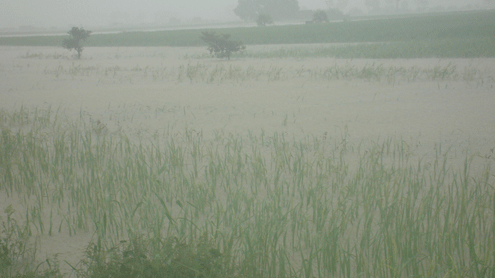By Jury Chai – Heavy rain falls in Mon state has caused severe flooding submerging many paddy fields say farmers.
“During the first week of June, heavy rain and the collection of water destroyed the paddy plants,” said a farmer from Balu-kyun Island of Chang Zone Township.

“It’s been raining every day so all the fields in the low area are destroyed by water and the paddy plants have died, although we tried to make a hole [to drain the water] but it flooded” the farmer added.
Because of the heavy rain, most of the paddy fields around Mon State have flooding and many small paddy plants have death, the farmers wait to rain stop and they will plant the paddy again.
In Southeast Asia, the rainy season normally begins in May and lasts until the end of October. Heavier rain tends to occur in the later months of the rainy season, mostly September and October, and thus, farmers were not prepared for the current intense rainfall.
Paddy fields situated close to a stream or river suffer the most from the flooding. Such paddy fields throughout the townships of Mudon, Chaung Zone and Ye in Mon State are more likely to be destroyed. Most paddy fields in these townships do not have a draining system to transfer water away from the fields.
“The heavy rain started about 20 days ago [and has lasted until now] and the entire field has flooded; some are just finishing the transplant of the paddy. Today there is less rain, but how will it be tomorrow, I am not sure. If the rain stops we will re-plant the paddy again” said a Yaung Daung village, Mudon Township resident.
Some fields which have flooded beyond salvaging have caused extreme financial losses for the farmers who will have to plant their paddy one more time. Farmers will need to buy new paddy seedlings as well as pay labor costs for the replanting of the paddy.
“After the water decreases we don’t know if the [rice] grain will die or live. Because the grain was submerged under water for about 10 days, if all of the plants die and we have to make the grain again, it will take so long [to regrow the paddy seedlings]” the Yaung Daung villager added.
The current price of kauk-gyi paddy is 700,000 Kyat per 100 baskets of paddy. Mudon Township farmers mainly plants this type of paddy. At the start of the rainy season, farmers plant the paddy seedlings, and the plant tends to start growing in the beginning of June.
The majority of people in Mon State work as farmers. Mon State is situated between the Gulf of Mataban on the west and Karen State on the east. Splitting the State in half is a motorway. The topography of the area to the east of the motorway is hilly and mostly planted with rubber trees, while the area to the west is flatter and planted with paddy. While the rubber plantations in the eastern part of the state are mostly government owned, most of the paddy farms are individually owned. Around 65% of the farmers in Mon State work on paddy farms.
